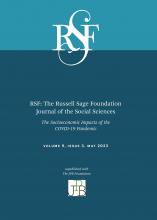Research Article
Open Access
Suffering, the Safety Net, and Disparities During COVID-19
Marianne P. Bitler, Hilary W. Hoynes, Diane Whitmore Schanzenbach
RSF: The Russell Sage Foundation Journal of the Social Sciences May 2023, 9 (3) 32-59; DOI: https://doi.org/10.7758/RSF.2023.9.3.02
Marianne P. Bitler
aProfessor of economics at the University of California, Davis
Hilary W. Hoynes
bHaas Distinguished Chair in Economic Disparities and professor of economics and public policy at the University of California, Berkeley
Diane Whitmore Schanzenbach
cMargaret Walker Alexander Professor of Human Development and Social Policy and director of the Institute of Policy Research at Northwestern University

REFERENCES
- ↵
- Aaronson, Stephanie
- ↵
- Aussenberg, Randy, and
- Kara Billings
- ↵
- Bauer, Lauren,
- Abigail Pitts,
- Krista Ruffini, and
- Diane Whitmore Schanzenbach
- ↵
- Bitler, Marianne P.,
- Annie Laurie Hines, and
- Marianne Page
- ↵
- Bitler, Marianne P., and
- Hilary W. Hoynes
- ↵
- Bitler, Marianne P., and
- Hilary W. Hoynes
- ↵
- Bitler, Marianne P., and
- Hilary W. Hoynes
- ↵
- Bitler, Marianne P.,
- Hilary W. Hoynes, and
- John Iselin
- ↵
- Bitler, Marianne P.,
- Hilary W. Hoynes, and
- Elira Kuka
- ↵
- Bitler, Marianne P.,
- Hilary W. Hoynes, and
- Diane Whitmore Schanzenbach
- ↵
- Bollinger, Christopher,
- Barry Hirsch,
- Charles Hokayem, and
- James Ziliak
- ↵
- Center on Budget and Policy Priorities
- ↵
- Center on Budget and Policy Priorities
- ↵
- Coleman-Jensen, Alisha,
- Matthew P. Rabbitt,
- Christian A. Gregory, and
- Anita Singh
- ↵
- Coleman-Jensen, Alisha,
- Matthew P. Rabbitt,
- Christian A. Gregory, and
- Anita Singh
- ↵
- Crandall-Hollick, Margot L
- ↵
- Cunnyngham, Karen
- ↵
- Duncan, Greg, and
- Suzanne Le Menestre
- ↵
- Flood, Sarah,
- Miriam King,
- Renae Rodgers,
- Steven Ruggles,
- J. Robert Warren, and
- Michael Westberry
- ↵
- Food and Nutrition Service
- ↵
- Food and Nutrition Service
- ↵
- Food and Nutrition Service
- ↵
- Fox, Liana
- ↵
- Fox, Liana, and
- Kalee Burns
- ↵
- Ganong, Peter,
- Pascal Noel, and
- Joseph Vavra
- ↵
- Gray, Colin
- ↵
- Hardy, Bradley,
- Tim Smeeding, and
- James Ziliak
- ↵
- Hill, Latoya, and
- Samantha Artiga
- ↵
- Homonoff, Tatiana, and
- Jason Somerville
- ↵
- Hoynes, Hilary W., and
- Diane Whitmore Schanzenbach
- ↵
- Hoynes, Hilary W., and
- Diane Whitmore Schanzenbach
- ↵
- Kuka, Elira, and
- Bryan A. Stuart
- ↵
- Larrimore, Jeff,
- Jacob Mortenson, and
- David Splinter
- Mathematica Policy Research
- Mathematica Policy Research
- Mathematica Policy Research
- ↵
- ↵
- Mueller, Andreas,
- Jesse Rothstein, and
- Till von Wachter
- ↵
- Parolin, Zachary,
- Elizabeth Ananat,
- Sophie Collyer,
- Megan Curran, and
- Christopher Wimer
- ↵
- Parolin, Zachary,
- Sophie Collyer,
- Megan Curran, and
- Christopher Wimer
- ↵
- Parolin, Zachary,
- Megan Curran,
- Jordan Matsudaira,
- Jane Waldfogel, and
- Christopher Wimer
- ↵
- Rothbaum, Jonathan, and
- Adam Bee
- ↵
- Shaefer, H. Luke,
- Sophie Collyer,
- Greg Duncan,
- Kathryn Edin,
- Irwin Garfinkel,
- David Harris,
- Timothy Smeeding,
- Jane Waldfogel,
- Christopher Wimer, and
- Hirokazu Yoshikawa
- ↵
- USAFacts
- ↵
- USASpending.gov
- U.S. Bureau of Labor Statistics (BLS)
- ↵
- U.S. Bureau of Labor Statistics (BLS)
- U.S. Census Bureau
- U.S. Census Bureau
- ↵
- U.S. Census Bureau
- ↵
- U.S. Census Bureau
- ↵
- U.S. Census Bureau
- ↵
- U.S. Census Bureau
- ↵
- U.S. Census Bureau
- ↵
- U.S. Department of Labor
- ↵
- U.S. Department of Labor
- ↵
- U.S. Department of the Treasury. Bureau of the Fiscal Service
- ↵
- Whittaker, Julia M., and
- Katelin P. Isaacs
- ↵
- ↵
- Ziliak, James
In this issue
Suffering, the Safety Net, and Disparities During COVID-19
Marianne P. Bitler, Hilary W. Hoynes, Diane Whitmore Schanzenbach
RSF: The Russell Sage Foundation Journal of the Social Sciences May 2023, 9 (3) 32-59; DOI: 10.7758/RSF.2023.9.3.02
Jump to section
Related Articles
- No related articles found.
Cited By...
- No citing articles found.





